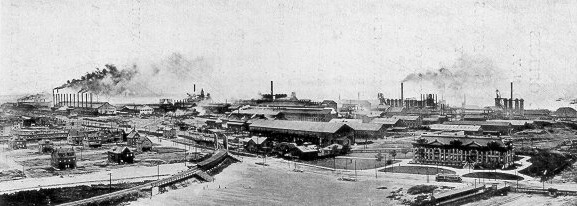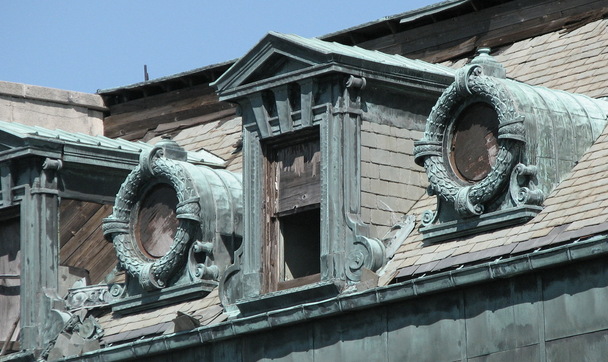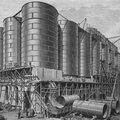
A view of the
Courtesy Steel Plant Museum, Inc.
Drawn by its proximity to Great Lakes commerce and numerous rail lines, William Walker Scranton determined to move the operation of the Lackawanna Iron and Steel Company from its birthplace in Scranton, Pennsylvania to the Buffalo suburb of West Seneca in 1899. By the end of the century, he had obtained the needed land through the local services of John J. Albright. The location chosen was a strip of waterfront south of the city of Buffalo and on the western side of the town of West Seneca.

The main office building of the Lackawanna Iron and Steel Company, shortly after its construction. The Beaux Arts influence on the building’s design is evident in its imposing presence, classical lines, pilasters, cornices and pediments.
Courtesy Steel Plant Museum. Inc.
Construction of a massive new steel mill began during the summer of 1900 and, when the company reorganized in 1902 as the Lackawanna Steel Company, it was the largest independent steel company in the world. One year earlier, as Buffalo was welcoming the world to the Pan-American Exposition, construction began on a company town near the mill. Though slow to develop, by 1909 it became the City of Lackawanna. Also constructed in 1901 was an elaborate building to hold the steel firm’s office. Located in the northeast corner of the mill complex, it was the design of New York City architect L.C. Holden. It is likely that William Scranton was already familiar with Holden’s work. In 1896 Holden designed the original clubhouse for the Country Club of Scranton, of which W.W. Scranton was a director.
Holden designed the Lackawanna Steel office building in the then-popular Beaux Arts style; a school also featured at the Pan-American Exposition. This highly-ornamented, classical style aped that taught in L’Ecole de Beaux Arts in

The office building as it appears today. Though it has seen better days, the original majesty of the building remains.
Douglas W. DeCroix Photo, 2009
In 1922, Lackawanna Steel was purchased by Bethlehem Steel. Under the Bethlehem name, the Lackawanna complex continued to be central to the American steel industry. During the Second World War, it was the largest steel mill in the world. By the early 1980s, however, the plant had closed and the 21st Century finds the future of the old steel complex and its once-elaborate office building in doubt. While the office building has been declared eligible for a National Register of Historic Places listing, the years of neglect have taken their toll. Lackawanna Mayor Norman Polanski, Jr. has labeled the building “beyond repair” and the City of Lackawanna is seeking funding through Restore NY to have the building demolished. Alternative solutions have been put forth, predictably some more practical than others. One suggests a re-use of the entire complex along the lines of Arthur P. Ziegler Jr.’s
Lackawanna, New York celebrates its centennial in 2009. Such events provide the dual opportunity for contemplating what has been and what perhaps is yet to be. The view towards the Lake Erie shoreline has certainly changed since 1909. The steel is gone and wind turbines now dot the mill’s former landscape, but the building which housed the nerve center of the Lackawanna Steel Company survives. Perhaps it is still possible to save at least a portion of this majestic reminder of the industry which gave birth – and a name – to the City of Lackawanna.










